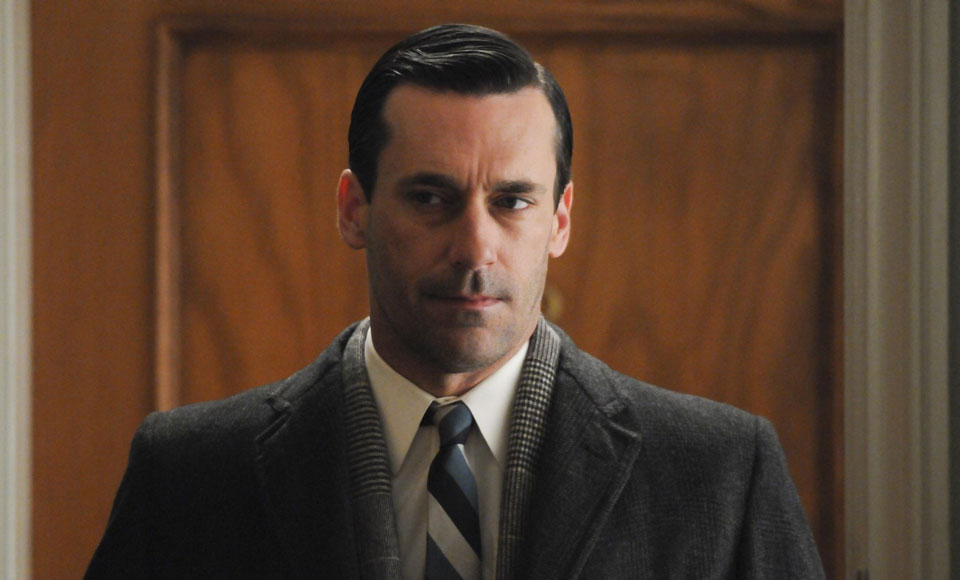|
Slick back hair has done the rounds as the finishing touch of a corporate uniform. It’s simple, clean, and says you’re here to get shit done. You might associate it with alpha male corporate warriors and sleazy sales guys in purple suits, but slick back hair can be the perfect antidote to a stale haircut that leaves you wanting something with a bit more punch. Slick back hair projects a mature, business-first quality, and is sufficiently timeless that it won’t be consigned to the trash heap of out-of-fashion looks anytime soon. There’s room for this beyond the office, too. By playing with different products to suit the environment, you can also adapt it for weekend adventures when the suit and tie stays in the wardrobe. This guide will give you a follicular roadmap to achieving a no-grease, no-sleaze slick back. You’ll discover whether your hair is up to the job, what products to use, and inspiring examples of the style to digest. Then, you can go back to watching Wall Street and studying stockbroking 101. Is Your Hair Right For The Job? Slick back hair is ubiquitous in western culture like bad dancing and guys called James, but that’s not to say it works for everyone. The texture, density, and growing pattern of your hair can make a huge difference in determining if you can pull the style off. For starters, you probably know already that straight hair lends itself to a slicked back style. Straight hair follows a simple pattern, which is crucial for the overall shape of the cut. Hair growth direction is important, too. For some guys, hair naturally grows forward, making it resistant to the comb-and-pomade two punch routine. If this sounds like you, then you need to think about getting cosy with a blow dryer and investing a bit more time in ‘training’ its shape. This won’t change the natural growing pattern, but it will make it slightly more co-operative to your styling attempts. Thick hair can be an obstacle to getting this style right. A slicked back haircut generally necessitates low to medium density hair. Anything thicker, and you’ll find it’s difficult to both slick the hair back and maintain its shape. If you’ve found that your hair doesn’t stay in place, or requires handfuls of product, then ask the barber to use thinning shears. This alleviates some of the density in your hair, making it easier to pull back with a comb. Think of it as an inconvenient blessing. It’s better to have thick hair than none at all. For curly haired gents, you might need to tap out early. It’s unlikely you’ll achieve Draper-esque slick style without investing your house mortgage in Olympic-pool quantities of pomade. That’s not to say the show can’t go on – you will just need to adapt the style to one that suits curly hair. These styles are messy off duty looks; think curly variations of David Beckham’s or a textured quiff. Slick Back Hair Products You’ve been to the local salon, and the product shelf seems to go on forever. There’s endless options for product out there – clay, paste, cream, pomade, gel, wax – and you might be feeling a bit of an information overload from all the choice. You’ll have the most success, however, if you keep it simple and stick to a pomade or clay – depending on the image you want to project. Pomade is a definitive classic. It offers old-school, vintage appeal and is also a lifesaver for windy days. Pomade can subdue unruly hair, and keep everything where you need it for sustained periods of time, due to its weight. On the other hand, too much pomade – particularly high-shine, oil based products – can lead you into Wall Street bank shark territory. Oil based pomades don’t wash out easily, either. As a result, water-based products are the best compromise for sufficient hold that won’t overstay its welcome after a solid washing. You will also find that pomade lends itself to a more formal, buttoned-up look that looks out of place in a casual environment. So if you want to incorporate a schmick 1950’s corporate look, pomade is the man for the job. Remember, less is more with pomade – start with a little bit, evenly through the hair, and work your way up. Handfuls of product are for lounge lizards and clueless teenagers. Clay is a more contemporary, versatile option. Clays come in a variety of options: heavy-duty concrete stuff for thick and unruly hair, or featherweight creams for something similar-but-not-quite pomade. Unlike oil or alcohol based products, clays are usually made with natural minerals (no nasty stuff). This adds texture and volume to your hair, which is ideal for casual effortlessness. You will need to test a few different options to find which clay suits you – thick hair needs extreme hold clays, while thin, straight hair is usually happy with a lightweight option. Clays are the natural option for the guy who doesn’t spend too much time in the corporate rat race, and doesn’t feel at home with shiny hair. No matter how desperate you find yourself, gel should stay on the shelf. Favoured by adolescents and early 2000’s revivalists, gel is usually alcohol-based, which will dehydrate your hair. Plus, it’s flammable. It’s unlikely that you will impress the girl at the bar if your head goes up in red-hot sparks. For a finishing touch, remember that hairspray can lock your hair into place. But please, use it sparingly. Most hairsprays add a glossy finish (too much of which will make your hair look like a helmet). They’re also about as flammable as a remix of Stayin Alive. A spray or two at key points, and nothing more. Tools & Equipment As for the tools of the trade, don’t be a sissy and tell yourself that blow-drying is for the fairer sex. Blow drying adds volume to your hair and is infinitely quicker than brutalising your scalp with a towel. However, don’t try to tough it out on the hottest setting possible. This will dry out your hair, and can even burn your scalp. Use it after some light towel drying, and don’t use it to completely dry your hair. Lastly, a good acetate or wooden comb is a proper investment. Plastic chemist combs are fragile and have weak teeth, which means you won’t achieve a strong, polished look. Spend a bit more at a legit barbershop and you’ll thank me later. Handy Tips Slick back hair (that doesn’t look like an 80’s Vegas loanshark) requires lots of love in the barber’s chair. You should opt for visits every three weeks. It sounds like a lot, but most have complimentary beers these days. This will allow the barber to maintain the ends of the fringe, and proportionate length everywhere else. If your hair is as dense as the slow kid in class, the barber can thin out your dome to keep things manageable. If you have a razor-sharp high fade, regular maintenance is doubly important. Fades can look sloppy without regular touch ups, which defeats the purpose of your barber’s precision handiwork in the first place. Hair care doesn’t end when you leave the salon. Don’t forget to wash your hair regularly. Using lots of pomade without a suitable interval (even if its water based) can make your hair as greasy as a late-night Big Mac. Products that don’t easily wash out, furthermore, can stay in your hair overnight and make it more difficult for you to style the next day. Extreme-hold clays can also leave flakes in your hair, making a good wash every now and then an absolute necessity. Washing will also stop your scalp from drying out, so it’s an essential pit stop on the road to a healthy haircut. Don’t wash too much, though – otherwise you’ll starve your follicles of their natural oils, which are there for a reason. The slick back doesn’t belong in the scrap heap of history, and the examples below demonstrate how the contemporary gent can make the most of the style. The Draper The classic executive needs no introduction. Businessmen have included this in their corporate armour for decades. It’s polished, tidy, and professional. Ask your barber to keep the top longer than the sides, with one edge of the fringe longer than the other. This’ll enable you to rakishly part it on one side. For a classic interpretation, maintain length on the sides of the head. This is a distinct 9-5 look, so opt for a textured, messier variant on the weekends. High-shine pomade will bring the look home but as I said earlier, less is more. This is suited to men with compliant, straight hair that isn’t too thick. The Wall Street The sleazy uncle of the executive slick back. Worn by hustlers, crooked finance guys, and corporate raiders. Where the classic style has shorter sides and a curved side part, this bad boy maintains even length through the entire cut and is swept back in a single direction. It’s a severe look, and not entirely common – but that’s not to say you shouldn’t release your inner Gordon Gekko. The best way to achieve this style is spend some time growing out the fringe and crown, while maintaining shorter sides. This will carry you through the awkward midpoint of growth, by allowing you to style it like a quiff in the interim. Steadily lengthen the sides and continue to brush them back as they get longer, until you can slick the crown and sides back in a unified fashion. Make sure the length is pretty well even-steven across the entirety of your head. And whatever you do, finish it cleanly just below your ears. A slicked mullet, unless you run a used car lot, is never a clever idea. Styling is just a case of grabbing a comb, industrially graded pomade, and getting in there. Blow dry your hair back to create the necessary shape and volume, without completely drying it. Heavy, oil based pomades usually do the trick. You may want to consider low-shine variants if you aren’t a stockbroker. The Beckham After he got bored of bleached tips and mullets, David Beckham grabbed the slickback by the throat and brought it into the 21st century. This is a trendy marriage between the pompadour and the classic slick back. You will need to achieve a few inches of growth on the top, while tapering the back short enough so you can slick back the front. Beckham prefers a slightly messy shape, and seems to use a combination of products. You can use a pomade for a glossy, formal interpretation, or rough it up with clay for messy texture. This is a style that is both safe and contemporary – it looks good on pretty much everyone, but resonates as an up-to-date interpretation of a traditional style. The Curly Quiff We haven’t forgotten those of you who don’t have straight, medium-density hair. For curly haired gents who can’t catch a break, this style is the light at the end of the tunnel. Growing this style is essentially the same as the Beckham, but adapted for curly hair. Keep the sides short, with a 2 or 3 fade. Taper the front so the back is an inch or so shorter, depending on the thickness of your hair. To style, make friends with clay. Curly hair doesn’t respond to pomade, generally, so a strong-hold clay will bring enough firepower to keep the look in place throughout the day.Input caption text here. Use the block's Settings tab to change the caption position and set other styles. The Undercut
Arguably the most popular short hairstyle of the last five years. Thanks to Boardwalk Empire and just about every other show with a stylish leading man, the undercut has done the rounds among the young and trying-to-stay-young as the haircut of the moment. To achieve this, you will need to spend a chunk of time growing out the front with a tapered crown. Maintain blended sides and a medium fade, until you can slick the top over to the back of your head. Otherwise, the cut will look tropical-fruit disproportionate. Afterwards, it’s a case of choosing a low or high fade. We recommend sitting somewhere in the middle. A super low fade can lead you into 80’s finance territory, while a high fade can unfortunately exaggerate the shape of your head. That being said, the undercut is doing the rounds for a reason. It’s as versatile as. You can slick it back with pomade, or use clays for a more natural approach. Works well for the 9-5 and off duty fun. Straight, medium-density hair is the ticket here, but it can work with curly hair if you’re not chasing the Jimmy Darmody look. This article first appeared on D'MARGE
1 Comment
A spokesperson for L’Oreal says that we might be seeing make-up counters at department stores devoted to men in the next five years. The UK managing director for L’Oreal, Vismay Sharma, told the Telegraph that the “selfie generation” isn’t so worried about gender taboos and might want to use make-up. “Today you have a very small proportion of men who want to use makeup products but that proportion is growing and it will continue to grow. I think it’s just awareness – two things are happening, men know they can use make up, and they know what it does when you use it.” Several other brands, like ASOS, have come out with a line of products directed at men, and designer Tom Ford has a collection of male beauty products that includes a concealer set. This trend actually contradicts Sharma’s argument that “the taboos are going.” Men can already purchase and use make-up, so if they need the word “male” slapped onto the same product to get them to use it, then they are still insecure in their masculinity. What will have changed – if more than a small percentage of men use these products – are the contours of what men are allowed to do. Moreover, makeup tutorials for men (and I’m guessing they’re aimed at straight men) focus on a “natural” and “subtle” look, which means that the point is to look like they’re not wearing make-up. If it’s no longer taboo for men we wear makeup, then why not put out ads with men wearing noticeable make-up and bold colors? But if men want to use makeup but need to be reassured that it’s masculine, then cosmetic companies will be ready to make money by selling households the same product twice with different packaging. This article appeared on Bilerico Report
Polished messiness is the secret How To Grow Out Your Hair Without Looking Like You’ve Given Up On Life
First things first, there’s something we need to make very clear. As you’ve probably seen with many a male celebrity, there is a world of difference between simply deciding not to cut your hair one day, and growing your hair out with actual effort. And yes, you can tell the difference between the two. There are a few things you can do to make sure you don’t fall into the former category though, starting with… Get As Many Opinions As Possible Before you decide to go full-Fabio, do a serious evaluation as to whether the product of your spent time and effort is actually gonna look good or not. Take a look in the mirror, use a snapchat filter, ask your family, ask your Mrs, ask your mates, ask anyone how they reckon you’d look with long hair. Also, don’t be afraid to cut it back if you don’t think it’s going to go as well as you thought. There’s no shame in trying, but we can’t all be Chris Hemsworth. Match Your Style To Your Features There’s a few things that can determine just how good your mane is likely to look, and they all rest on your face. Having thicker hair in certain places (for instance a heavier top and thinner sides, or vice versa), can help accentuate or balance the features of your mug, meaning it’s important to get everything proportioned correctly. If you have large features (big nose, big lips etc.) or a rounder face, go for bigger, larger, more textured styles to soften them. Early Mick Jagger is a good example. If you have smaller features and a thinner face, a thinner, longer style is probably more suitable. Think Zlatan or Jared Leto. Adjust Your Style As It Grows Of course, before you reach a glorious mane you’re going to go through months of awkward lengths, styles and unruliness that’ll make you question whether or not you want to continue. The answer to this issue is twofold. One, make sure you’re giving your hair the best chance to grow healthily by eating a decent diet and using conditioning products as it grows. Two. Don’t be afraid to get a little product involved to keep things looking presentable. It’ll take time for your hair to reach a long enough length to weigh itself down and look properly natural, so you may have to compromise for a while. Once It’s Grown, Let Your Barber Take the Reigns If you’ve grown your hair out right, it should need as little maintenance as possible to make it look good. If you want to blow dry it, go for it, but lay off on the styling products, unless of course you’re trying out for a Motley Crue tribute act. The hallmark of a grown-out hairstyle that works is that it should look good sitting naturally. If it doesn’t, then let your barber fix it or consider a change of style altogether. That being said, take care of your hair. Short hair might let you get away with being a little more relaxed on the shampoo and conditioner, but as any girl will tell you, long hair won’t afford you that luxury. Always Keep It In Check Keeping your hair healthy often boils down to making sure you’re touching it as little as possible, but depending on how long you decide to go, you’re gonna have to figure out ways to make sure it’s not going everywhere when you’re playing sport, doing manual labour or even just walking in a windy day. The key here is to experiment with what suits you. Take as much inspiration as you’d like when it comes to buns, ponytails, headbands, bandannas or whatever, as long as you’re avoiding the top knot. This article first appeared on D’MARGE 10 Essential Tips to Protect |
Hair by BrianMy name is Brian and I help people confidently take on the world. CategoriesAll Advice Announcement Awards Balayage Barbering Beach Waves Beauty News Book Now Brazilian Treatment Clients Cool Facts COVID 19 Health COVID 19 Update Curlies EGift Card Films Follically Challenged Gossip Grooming Hair Care Haircolor Haircut Hair Facts Hair History Hair Loss Hair Styling Hair Tips Hair Tools Health Health And Safety Healthy Hair Highlights Holidays Humor Mens Hair Men's Long Hair Newsletter Ombre Policies Procedures Press Release Previous Blog Privacy Policy Product Knowledge Product Reviews Promotions Read Your Labels Recommendations Reviews Scalp Health Science Services Smoothing Treatments Social Media Summer Hair Tips Textured Hair Thinning Hair Travel Tips Trending Wellness Womens Hair Archives
January 2025
|
|
Hey...
Your Mom Called! Book today! |
Sunday: 11am-5pm
Monday: 11am-6pm Tuesday: 10am - 6pm Wednesday: 10am - 6pm Thursday: By Appointment Friday: By Appointment Saturday: By Appointment |













 RSS Feed
RSS Feed